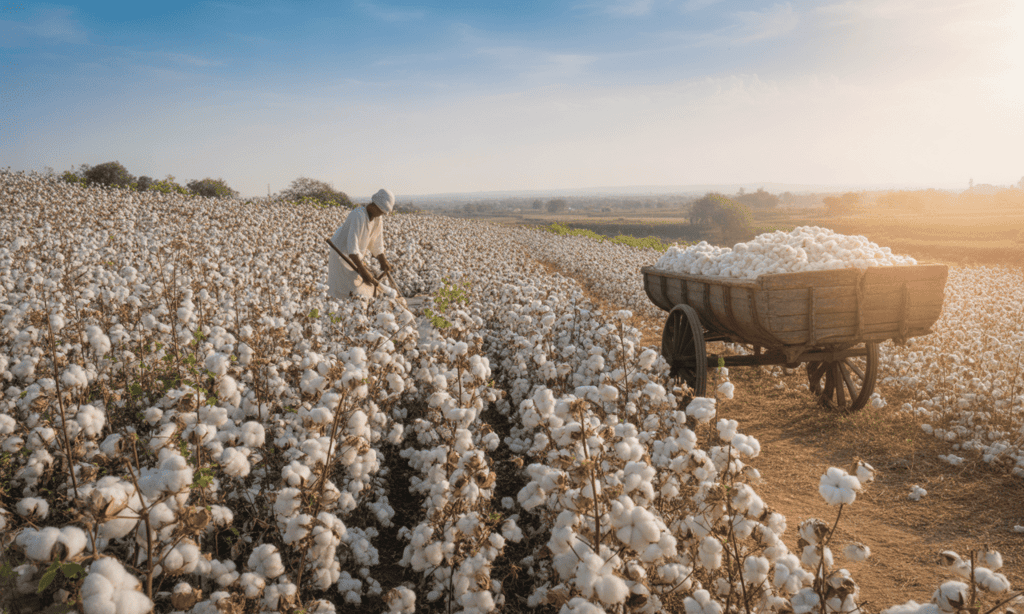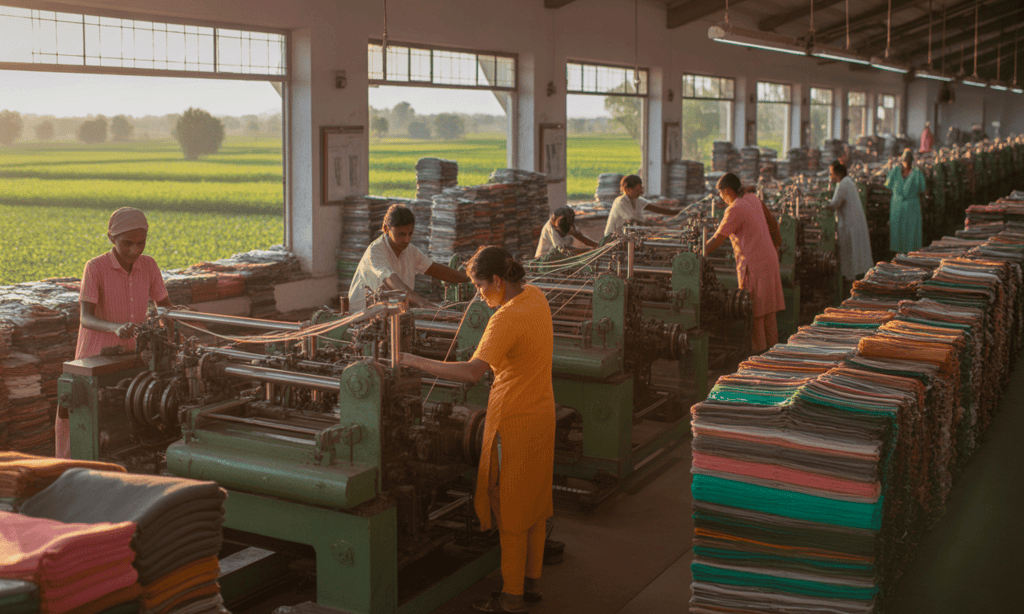Unit Test (Solutions): Manufacturing Industries | Social Studies (SST) Class 10 PDF Download
Time: 1 Hour
M.M.: 30
Instructions: Attempt all questions.
- Question numbers 1 to 5 carry 1 mark each.
- Question numbers 6 to 8 carry 2 marks each.
- Question numbers 9 to 11 carry 3 marks each.
- Question numbers 12 & 13 carry 5 marks each.
Q1. Which one of the following is an example of an agro-based industry? (1 Mark)
a) Iron and steel
b) Cotton textile
c) Cement
d) Aluminium smelting
Ans: b) Cotton textile
Cotton textile is an agro-based industry as it relies on agricultural raw materials, unlike the other options which are mineral or heavy industries.

Q2. What is the maximum investment allowed for a small-scale industry in India? (1 Mark)
a) ₹50 lakh
b) ₹1 crore
c) ₹5 crore
d) ₹10 crore
Ans: b) ₹1 crore
The maximum investment limit for a small-scale industry in India is currently set at ₹1 crore, which has been updated over time.
Q3. Which one of the following states has the highest concentration of jute mills in India? (1 Mark)
a) Maharashtra
b) West Bengal
c) Uttar Pradesh
d) Tamil Nadu
Ans: b) West Bengal
West Bengal is known for having the highest concentration of jute mills in India, primarily due to its favorable climate and availability of raw jute.
Q4. Which statement is true regarding the iron and steel industry? (1 Mark)
a) It is classified as a light industry.
b) It is considered the backbone of industrial development.
c) It primarily uses agricultural raw materials.
d) It is mainly a consumer industry.
Ans: b) It is considered the backbone of industrial development.
The iron and steel industry is often referred to as the backbone of industrial development due to its critical role in providing essential materials for various sectors.
Q5. Which one of the following is a major cause of thermal pollution? (1 Mark)
a) Noise from machinery
b) Discharge of hot water from factories into rivers
c) Burning of fossil fuels
d) Excessive groundwater extraction
Ans: b) Discharge of hot water from factories into rivers
Discharge of hot water from factories into rivers is a significant cause of thermal pollution, as it raises the water temperature and disrupts aquatic ecosystems.
Q6. Explain the importance of the manufacturing sector in reducing unemployment and poverty in India. (2 Mark)
Ans: The manufacturing sector plays a crucial role in reducing unemployment and poverty in India through several key mechanisms:
- Manufacturing industries provide a wide range of jobs, helping to decrease reliance on agricultural income.
- Industrial development is essential for tackling unemployment and poverty, as seen in public sector initiatives aimed at regional development.
- By exporting manufactured goods, India enhances trade and generates foreign exchange, which is vital for economic stability.

Q7. Differentiate between agro-based and mineral-based industries with examples. (2 Mark)
Ans: Agro-based industries use raw materials derived from agriculture. Examples include:
- Textiles - made from cotton, wool, and silk.
- Vegetable oil - extracted from seeds.
- Sugar - produced from sugarcane.
Mineral-based industriesrely on minerals and metals as raw materials. Examples include:
- Iron and Steel - essential for construction and manufacturing.
- Cement - used in building and infrastructure.
- Aluminium - utilised in various applications like packaging and transportation.
Q8. Why are most jute mills located along the Hugli River in West Bengal? (2 Mark)
Ans: The majority of jute mills are situated along the Hugli River in West Bengal due to several key factors:
- Proximity to jute-producing areas, ensuring easy access to raw materials. Inexpensive water transport for moving raw jute to the mills.
- A well-developed network of railways, roadways, and waterways to facilitate logistics. Abundant water supply necessary for processing jute.
- Availability of cheap labour from West Bengal and nearby states like Bihar, Odisha, and Uttar Pradesh.
- Kolkata, as a major urban centre, offers essential banking, insurance, and port facilities for exporting jute products.
Q9. Discuss the role of the textile industry in the Indian economy, highlighting its contribution to employment and foreign exchange. (3 Mark)
Ans: The textile industry plays a crucial role in the Indian economy, contributing significantly to both employment and foreign exchange earnings. Key points include:
- The industry is a major source of employment, providing jobs to millions, including farmers, weavers, and workers in various stages of production. It supports numerous ancillary industries such as chemicals, dyes, and packaging, creating a ripple effect in the economy.
- India is renowned for its cotton textiles, with historical roots in hand spinning and weaving, which have evolved with the introduction of power looms.
- The industry is decentralised, allowing for the incorporation of traditional skills in weaving, particularly in states like Maharashtra, Gujarat, and Tamil Nadu.
- Manufacturing in textiles not only boosts agricultural productivity but also reduces dependency on agricultural income. Exporting textile products enhances foreign exchange earnings, contributing to national prosperity.
Q10. Differentiate between public sector and cooperative sector industries with examples. (3 Mark)
Ans: Public Sector Industries:
- Owned and operated by government agencies.
- Examples include BHEL and SAIL.
Cooperative Sector Industries:
- Owned and managed by producers or suppliers of raw materials.
- They pool resources and share profits or losses.
- Examples include the sugar industry in Maharashtra and the coir industry in Kerala.
Key Differences:
- Public sector focuses on government ownership, while cooperatives focus on collective ownership.
- Public sector aims for public welfare; cooperatives aim for member benefits.
Q11. What are the consequences of industrial pollution on the environment? (3 Mark)
Ans: Consequences of industrial pollution on the environment
- Air pollution: Emission of harmful gases like sulphur dioxide and carbon monoxide from factories can lead to serious health issues.
- Water pollution: Industrial waste, including chemicals and heavy metals, contaminates rivers and lakes, harming aquatic life.
- Land pollution: Dumping of waste materials, including plastics and chemicals, degrades soil quality and affects agriculture.
- Noise pollution: Industrial activities generate excessive noise, which can cause stress and health problems like hearing loss.
Industries, including thermal power plants, contribute significantly to these forms of pollution. Effective measures are needed to mitigate these impacts, such as:
- Recycling and reusing water in industrial processes.
- Treating wastewater before discharge.
- Implementing noise reduction technologies in machinery.
Q12. Describe the factors that make the Chhotanagpur plateau an ideal location for the iron and steel industry. Suggest measures to reduce the environmental impact of this industry. (5 Mark)
Ans: The Chhotanagpur plateau is an ideal location for the iron and steel industry due to several key factors:
- Abundant Resources: The region has rich deposits of iron ore, coking coal, and limestone, essential for steel production.
- Cost-Effective Labour: There is a large supply of inexpensive labour, reducing overall production costs.
- Proximity to Markets: The plateau's location allows easy access to major markets, facilitating distribution.
- Infrastructure: Well-developed transport networks, including roads and railways, support efficient logistics.
To reduce the environmental impactof the iron and steel industry, the following measures can be implemented:
- Waste Management: Implement recycling and reuse of water in processing to minimise waste.
- Effluent Treatment: Treat wastewater before discharge to protect freshwater sources.
- Emission Controls: Use technology like electrostatic precipitators and scrubbers to reduce air pollution.
- Green Initiatives: Establish green belts around industrial areas to enhance ecological balance.
Q13. Discuss the importance of the textile industry in the Indian economy. Choose any two segments (cotton, jute, or silk) and describe their production processes and contributions to foreign exchange earnings. (5 Mark)
Ans: The textile industry plays a vital role in the Indian economy, significantly contributing to industrial production, employment, and foreign exchange earnings. It is unique as it is self-reliant and encompasses the entire value chain, from raw materials to finished products. Focusing on two segments, cotton and jute, we can see their production processes and contributions:
- Cotton Textiles:
- Traditionally produced using hand spinning and handloom weaving.
- Power looms were introduced in the 18th century, enhancing production.
- The first successful textile mill was established in Mumbai in 1854.
- Concentrated in states like Maharashtra and Gujarat due to the availability of raw cotton and transport facilities.
- Supports various industries, including chemicals, dyes, and packaging.
- Jute Textiles:
- India is the largest producer of raw jute and ranks second in exports after Bangladesh.
- Most jute mills are located in West Bengal, particularly along the Hugli River.
- The first jute mill was established in 1855 near Kolkata.
- Post-Partition, India retained the mills, while a significant portion of jute cultivation moved to Bangladesh.
- Jute production contributes to foreign exchange through exports.
|
94 videos|630 docs|79 tests
|
FAQs on Unit Test (Solutions): Manufacturing Industries - Social Studies (SST) Class 10
| 1. What are the main types of manufacturing industries? |  |
| 2. How do manufacturing industries impact the economy? |  |
| 3. What are the challenges faced by manufacturing industries today? |  |
| 4. What role does technology play in manufacturing industries? |  |
| 5. Why is sustainability important in manufacturing industries? |  |
















